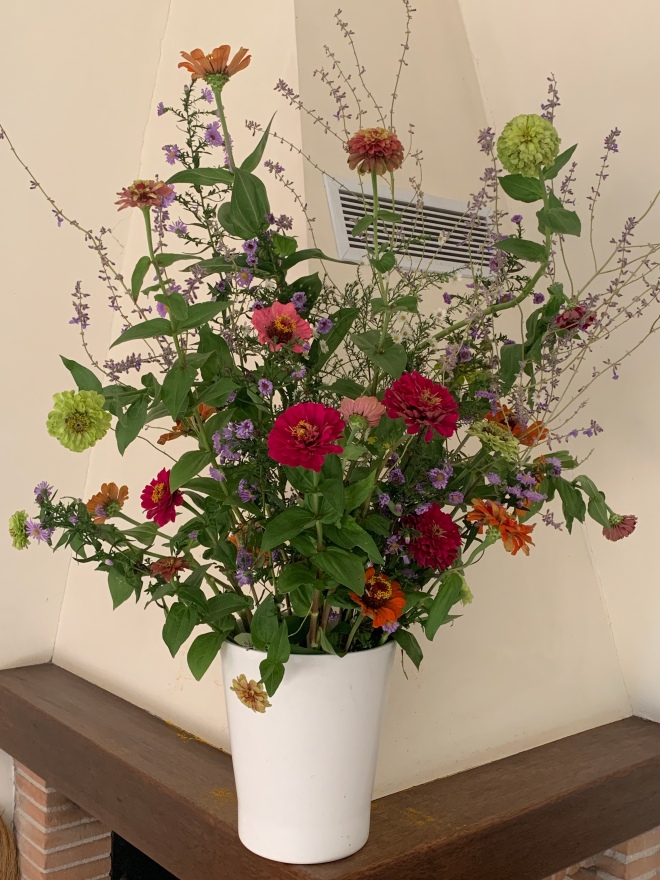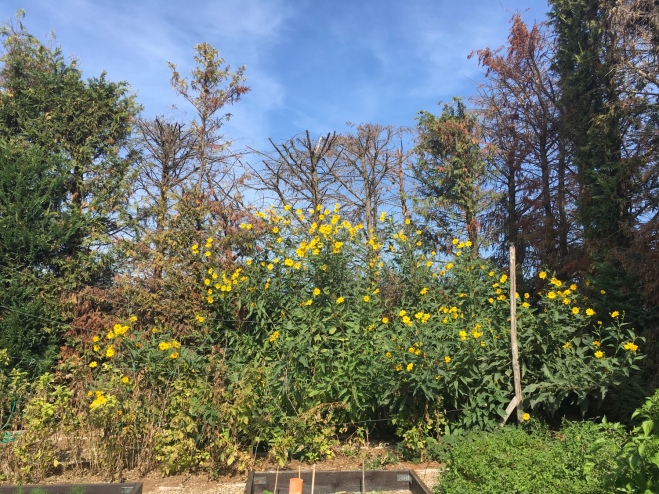Hello to you all. Some of you have been kind enough to email me asking how we are surviving in Italy when I know the headlines around the world are suggesting conditions are dire here. Yet me reassure you that we are well. Continue reading
Wordless Wednesday sunny November day

IAVOM – Zinnias the stars
With the rain even the Zinnias are looking fresher and producing quite prolifically again.

There are Zinnias, Asters including ‘Monte Cassino’, Holy Basil flowers and seed heads and some Achillea.

Above a larger arrangement in the sitting room with the same flowers as above with the addition of Perovskia.
With my thanks to Cathy at ‘ Rambling in the Garden’ who hosts this popular meme.
I have been using my phone for my recent posts. Do you notice any difference in the quality of the images?
The garden comes back to life
In August I hate the garden. Everything, including supposedly drought tolerant plants like Cistus) looks dead. But then September usually brings some relief with slightly lower temperatures and some rain – this year a lot of rain.








I hope your garden is giving you pleasure at this time of year.
September vase
Every year at this time the Jerusalem artichokes begin to flower.
They look quite amazing in the garden.

The tallest that are supporting themselves on the dead Leylandii must be well over 2 metres tall. I find it impossible to thin the tubers out enough to get a harvestable crop, but I do enjoy the flowers as it is lovely to have something different at this time of year.
The other September flower is of course what we used to call Asters (that’s what I’m still calling them). Here they are even called Setembrini.
So I filled a large vase with just these two flowers.

Placed on the mantle shelf in the sitting room, I’m enjoying this splash of colour very much.
In a vase on Monday – hot orange
It’s Monday and I have a vase, so I’m joining Cathy at Rambling in the Garden https://public-api.wordpress.com/bar/?stat=groovemails-events&bin=wpcom_email_click&redirect_to=https%3A%2F%2Framblinginthegarden.wordpress.com%2F2019%2F08%2F05%2Fin-a-vase-on-monday-dotty%2F&sr=1&signature=2d97f929b19ddb142313ef2ddf815c6d&user=11751235&_e=eyJlcnJvciI6bnVsbCwiYmxvZ19pZCI6MzQwMTU0MjUsImJsb2dfbGFuZyI6ImVuIiwic2l0ZV9pZF9sYWJlbCI6IndwY29tIiwiZW1haWxfbmFtZSI6ImVtYWlsX3N1YnNjcmlwdGlvbiIsIl91aSI6MTE3NTEyMzUsImVtYWlsX2lkIjoiY2NiOWMxODM4MDQ2YzRlMjE2YjFiNDVlN2FlOWUwMDgiLCJkYXRlX3NlbnQiOiIyMDE5LTA4LTA1IiwiZG9tYWluIjoicmFtYmxpbmdpbnRoZWdhcmRlbi53b3JkcHJlc3MuY29tIiwiZnJlcXVlbmN5IjoiMCIsImRpZ2VzdCI6IjAiLCJoYXNfaHRtbCI6IjEiLCJsb2NhbGUiOiJlbiIsImFuY2hvcl90ZXh0IjoiSW4gYSBWYXNlIG9uIE1vbmRheTpcdTAwYTBEb3R0eSIsIl9kciI6bnVsbCwiX2RsIjoiXC93cC1jcm9uLnBocD9kb2luZ193cF9jcm9uPTE1NjQ5OTIwNjUuNjc5MDY1OTQyNzY0MjgyMjI2NTYyNSIsIl91dCI6IndwY29tOnVzZXJfaWQiLCJfdWwiOiJidW9uYWZvcmNoZXR0YSIsIl9lbiI6IndwY29tX2VtYWlsX2NsaWNrIiwiX3RzIjoxNTY0OTkyMTMwNTEzLCJicm93c2VyX3R5cGUiOiJwaHAtYWdlbnQiLCJfYXVhIjoid3Bjb20tdHJhY2tzLWNsaWVudC12MC4zIiwiYmxvZ190eiI6IjEiLCJ1c2VyX2xhbmciOiJlbiJ9&_z=z with a vase I made for the table on Saturday.

It’s looking a bit the worse for wear now because it is so hot., but the Zinnias and Dahlias are doing quite well.
In a vase on Monday – Glorious Irises
This week another vase from me that was a gift for my lunch hostess yesterday. On this occasion when I asked what I could bring she said she would love flowers from my garden – a real compliment as flowers are rarely a hostess gift here (only I seem to do it).
So the flowers where picked yesterday and as I know she loves flowers I tried to take what is best at this moment in my garden, and that has to be Irises! Continue reading
The Gargano, Puglia with a like minded blogger in search of orchids
Last Wednesday saw us leave home early for the drive down to the Gargano in Puglia to meet with Chloris of The Blooming Garden who was spending a holiday there. We are both posting about the experience at the same time so you can overdose on orchids by reading both our posts.
The Gargano is known to be one of the top sights in the world for wild flowers and this is the season. For those unsure where the Gargano is situated it is the spur that sticks out from the Italian boot; at one time it was an island and so there are several species of plants and animals that are special and only found there.
Chloris and her husband were waiting for us when we arrived and so with the impatience that only the passionate plant hunter will understand we set off almost immediately.
We saw many wonderful wild flowers, but I’m going to share with you just the orchids today. Chloris is a very knowledgeable plants woman so I felt especially lucky sharing time with her; our respective partners were relatively tolerant of our constant squeals of delight as we found a new (or possible new) flower.
Before we even arrived at the hotel, on a road that only Goggle maps would use, my husband said “you should start looking for orchids now” – actually I had been looking already but within about 1 minute of him saying this I could hardly believe that we were driving past a small field with tall stems of Orchis purpurea, The Lady Orchid.
This was the tallest orchid we found standing at about 75 cm.
As I’ve shown you the Lady Orchis, I’d better show you the Man Orchid; we saw these in each of the sites we visited.
It isn’t so obvious why the Man Orchid is so called but for the Naked Man Orchid it is blatantly correct as a name.
One of the things that made the Gargano so special was that in places where we found orchids there were hundreds if not thousands of them.
The example below appears to be a cross between Orchis italica and Anacampis morio, I must say he does seem particularly well endowed!
The problem with all the orchid species is that the book I have states at the beginning of almost every description that there are many hybrids that some people believe to be separate species; given this and the fact that some species have very wide variations in colour and even to some extent in form I think that unless you are an expert it is almost impossible to be positive about any identification, so please if you think any of my names are incorrect please leave a comment. Chloris is very good with her identification and also she bought a book about orchids specifically in the Gargano, so I am indebted to her for most of these id’s.
We saw many different-looking butterfly orchids but cannot reliably identify them. Below are some of the variations.
Anacamptis is the most infuriating species as it comes in many different colours which when you find them you are sure they are something completely different.
Then come the bee orchids; all very distinctive but again many hybrids or different forms are listed as different species; I imagine that Chloris will enlighten us more about this in here post so don’t forget to follow the links to here post.
The above two are a good example; they might be distinct species or maybe the second is Orphys passionis sub. sp. garganica.
Although all the bee orchids are similar they are pollinated by different insects.
You can imagine the grasps of delight when we saw this field.
If you’d like to see how I got the above image go to Chloris’s post here.
In a vase on Monday – very pink
Life has been busy, but in a good way; I missed the Easter Monday IAVOM, although I had made two vases one as a gift for our hostess for Easter Sunday lunch and a basket of spring flowers for a Pizza lunch I hosted for ‘Pasquetta’ – Easter Monday. Continue reading
In a vase on Monday – Dutch Irises
Another Monday, another vase to share with all the followers of Cathy at Rambling in the Garden, who asks us to find flowers to cut from our gardens and bring into our homes to enjoy. Continue reading























